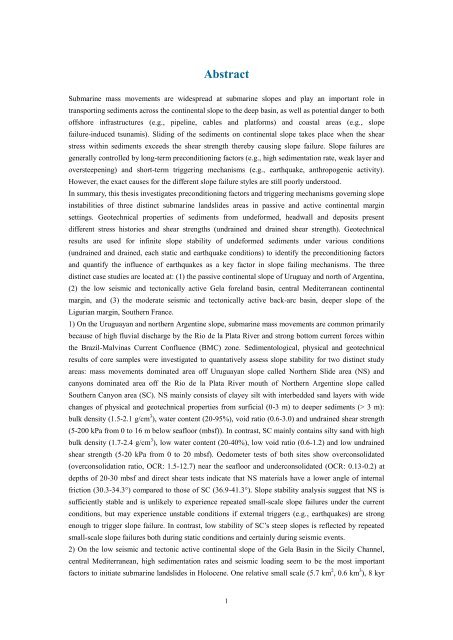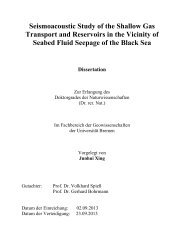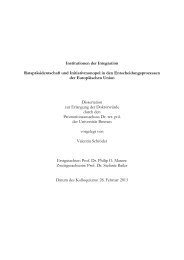Slope stability along active and passive continental margins ... - E-LIB
Slope stability along active and passive continental margins ... - E-LIB
Slope stability along active and passive continental margins ... - E-LIB
Create successful ePaper yourself
Turn your PDF publications into a flip-book with our unique Google optimized e-Paper software.
Abstract<br />
Submarine mass movements are widespread at submarine slopes <strong>and</strong> play an important role in<br />
transporting sediments across the <strong>continental</strong> slope to the deep basin, as well as potential danger to both<br />
offshore infrastructures (e.g., pipeline, cables <strong>and</strong> platforms) <strong>and</strong> coastal areas (e.g., slope<br />
failure-induced tsunamis). Sliding of the sediments on <strong>continental</strong> slope takes place when the shear<br />
stress within sediments exceeds the shear strength thereby causing slope failure. <strong>Slope</strong> failures are<br />
generally controlled by long-term preconditioning factors (e.g., high sedimentation rate, weak layer <strong>and</strong><br />
oversteepening) <strong>and</strong> short-term triggering mechanisms (e.g., earthquake, anthropogenic activity).<br />
However, the exact causes for the different slope failure styles are still poorly understood.<br />
In summary, this thesis investigates preconditioning factors <strong>and</strong> triggering mechanisms governing slope<br />
instabilities of three distinct submarine l<strong>and</strong>slides areas in <strong>passive</strong> <strong>and</strong> <strong>active</strong> <strong>continental</strong> margin<br />
settings. Geotechnical properties of sediments from undeformed, headwall <strong>and</strong> deposits present<br />
different stress histories <strong>and</strong> shear strengths (undrained <strong>and</strong> drained shear strength). Geotechnical<br />
results are used for infinite slope <strong>stability</strong> of undeformed sediments under various conditions<br />
(undrained <strong>and</strong> drained, each static <strong>and</strong> earthquake conditions) to identify the preconditioning factors<br />
<strong>and</strong> quantify the influence of earthquakes as a key factor in slope failing mechanisms. The three<br />
distinct case studies are located at: (1) the <strong>passive</strong> <strong>continental</strong> slope of Uruguay <strong>and</strong> north of Argentina,<br />
(2) the low seismic <strong>and</strong> tectonically <strong>active</strong> Gela forel<strong>and</strong> basin, central Mediterranean <strong>continental</strong><br />
margin, <strong>and</strong> (3) the moderate seismic <strong>and</strong> tectonically <strong>active</strong> back-arc basin, deeper slope of the<br />
Ligurian margin, Southern France.<br />
1) On the Uruguayan <strong>and</strong> northern Argentine slope, submarine mass movements are common primarily<br />
because of high fluvial discharge by the Rio de la Plata River <strong>and</strong> strong bottom current forces within<br />
the Brazil-Malvinas Current Confluence (BMC) zone. Sedimentological, physical <strong>and</strong> geotechnical<br />
results of core samples were investigated to quantatively assess slope <strong>stability</strong> for two distinct study<br />
areas: mass movements dominated area off Uruguayan slope called Northern Slide area (NS) <strong>and</strong><br />
canyons dominated area off the Rio de la Plata River mouth of Northern Argentine slope called<br />
Southern Canyon area (SC). NS mainly consists of clayey silt with interbedded s<strong>and</strong> layers with wide<br />
changes of physical <strong>and</strong> geotechnical properties from surficial (0-3 m) to deeper sediments (> 3 m):<br />
bulk density (1.5-2.1 g/cm 3 ), water content (20-95%), void ratio (0.6-3.0) <strong>and</strong> undrained shear strength<br />
(5-200 kPa from 0 to 16 m below seafloor (mbsf)). In contrast, SC mainly contains silty s<strong>and</strong> with high<br />
bulk density (1.7-2.4 g/cm 3 ), low water content (20-40%), low void ratio (0.6-1.2) <strong>and</strong> low undrained<br />
shear strength (5-20 kPa from 0 to 20 mbsf). Oedometer tests of both sites show overconsolidated<br />
(overconsolidation ratio, OCR: 1.5-12.7) near the seafloor <strong>and</strong> underconsolidated (OCR: 0.13-0.2) at<br />
depths of 20-30 mbsf <strong>and</strong> direct shear tests indicate that NS materials have a lower angle of internal<br />
friction (30.3-34.3°) compared to those of SC (36.9-41.3°). <strong>Slope</strong> <strong>stability</strong> analysis suggest that NS is<br />
sufficiently stable <strong>and</strong> is unlikely to experience repeated small-scale slope failures under the current<br />
conditions, but may experience unstable conditions if external triggers (e.g., earthquakes) are strong<br />
enough to trigger slope failure. In contrast, low <strong>stability</strong> of SC’s steep slopes is reflected by repeated<br />
small-scale slope failures both during static conditions <strong>and</strong> certainly during seismic events.<br />
2) On the low seismic <strong>and</strong> tectonic <strong>active</strong> <strong>continental</strong> slope of the Gela Basin in the Sicily Channel,<br />
central Mediterranean, high sedimentation rates <strong>and</strong> seismic loading seem to be the most important<br />
factors to initiate submarine l<strong>and</strong>slides in Holocene. One relative small scale (5.7 km 2 , 0.6 km 3 ), 8 kyr<br />
1
















